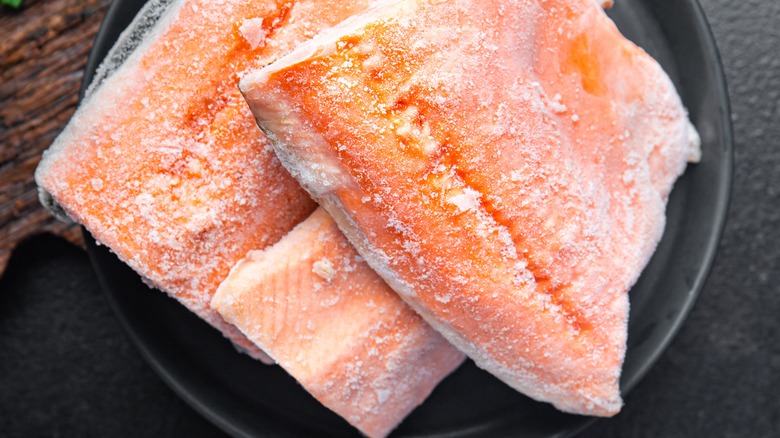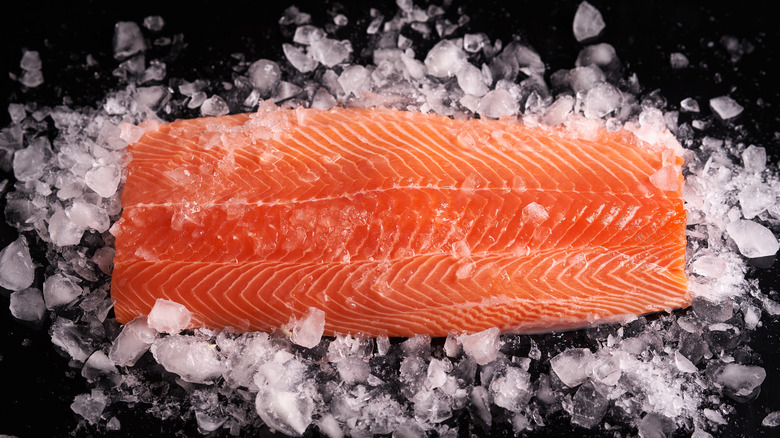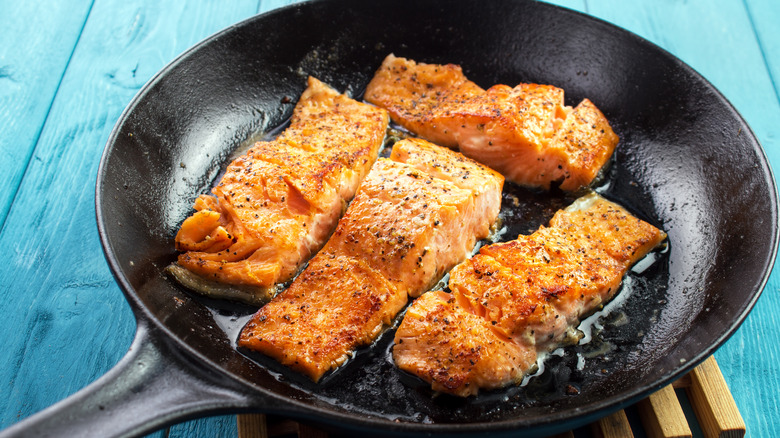Can You Cook Frozen Salmon Without Thawing It First?
Professional and amateur cooks alike face hurried moments in which expectations don't match reality, especially when it comes to planning time in the kitchen. For those nights you find yourself staring down frozen bricks of salmon wondering if it is actually necessary to thaw the fish before cooking it, we have answers for you.
Frozen salmon is often cheaper than buying fillets fresh, so stocking your freezer with frozen pieces of fish can help you set healthy, delicious meals on the dining table, particularly on busy weeknights. While salmon is typically thawed in water, in the refrigerator, or even in the microwave, you may not need to thaw that fillet of salmon at all — depending on what you're hoping to whip up for tonight's meal.
Forgetting to place frozen fish into the fridge to thaw isn't the end of your dinner plans, but before you start cooking anything, first note the size of the frozen salmon you have on your hands. Using frozen fillets in recipes works best for smaller pieces of fish.
Baking and poaching frozen salmon
If the recipe you're preparing calls for poached or baked salmon, the steady temperature at which you're making the fish can help you cook frozen fillets at safe temperatures. The overall cooking time will need to be adjusted — estimate that it will take about 50% longer to cook than what the recipe calls for — since it will take longer for the middle of the fish to be properly cooked through, but you can check the temperature of the fish throughout the process.
Before you incorporate the frozen protein into your recipes, make sure to rinse the fish to help remove any ice that might have formed on its skin. When that's done you'll also want to make sure the fillet is dry. You can use paper towels to pat down the skin.
Since seasoning and herbs won't stick to the skin of rock-hard fish, you'll need to bake the frozen piece for a few minutes, remove the fillet to season it, and then return it back to the oven to finish baking. Frozen salmon can also be pan-seared and placed onto grills, but you'll need to handle the fish differently than if it was already thawed.
Making adaptions if you're grilling or frying
While baking or poaching frozen salmon just means adding more cooking time, you'll have to make bigger changes to the cooking process if you're grilling or frying.
To grill pieces of frozen salmon, it is best to cover the fish with your choice of marinade and wrap each piece before placing the fillets onto the grill. Covering the salmon with grape leaves or corn husks will prevent any piece of the fish from sticking to the grill and protect your precious mains from falling in between the grates of the grill.
Pan-frying frozen salmon is a fairly similar process. First wash the fillet to remove any ice, dry the salmon, and place the unseasoned fish into the pan. Only after you've pan-fried one side and flipped the fish can you start adding your preferred herbs and seasonings. Then, cover the skillet with a lid to ensure the protein cooks properly. Place the fish in the pan skin-side down so that the exterior of the fish crisps nicely and you don't end up with a mushy, disappointing dish to serve.
Though it's a little more complicated than baking or poaching, grilling or pan-frying frozen salmon is still very simple and totally doable any night of the week. Keep these tips in mind and salmon your freezer, you'll never have to think ahead for dinner again.


